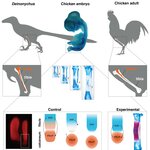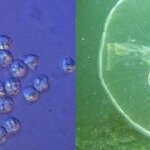Evolution

Researchers have identified unique anatomical features in a species of blind, walking cavefish in Thailand that enable the fish to walk and climb waterfalls in a manner comparable to tetrapods, or four-footed mammals and amphibians.
The discovery of this capability, not seen in any other living fishes, also has implications for understanding how the anatomy that all species need to walk on land evolved after the transition from finned to limbed appendages in the Devonian period, which began some 420 million years ago.
This research is reported in Scientific Reports ("Tetrapod-like pelvic…

Anyone that has eaten chicken knows what a drumstick is - it's the lower leg of a long, spine-like bone, more specifically the fibula, one of the two long bones of the lower leg (the outer one).
In dinosaurs, the ancestors of birds, this bone is tube-shaped and reaches all the way down to the ankle, but in evolution birds lost the lower end, and no longer connects to the ankle, being shorter than the other bone in the lower leg, the tibia. In the 19th century, scientists had noted that bird embryos first develop a tubular, dinosaur-like fibula. Only afterwards, it becomes shorter than the…

Researchers have identified a common ancestral gene that enabled the evolution of advanced life over a billion years ago. The gene, found in all complex organisms, including plants and animals, encodes for a large group of enzymes known as protein kinases that enabled cells to be larger and to rapidly transfer information from one part to another.
Plants, animals, mushrooms and more all exist because they are made up of eukaryotic cells that are larger and far more complex than bacteria. Inside of these eukaryotic cells are hundreds of organelles that perform diverse functions to keep…

Chimpanzees have an ancient common ancestor - or genetic 'Adam' - that lived over one million years ago, according to a new paper paper in the journal Genome Research.
The research team led by Professor Mark Jobling from the University of Leicester's Department of Genetics determined the DNA sequences of a large part of the Y chromosome, passed exclusively from fathers to sons, in a set of chimpanzees, bonobos, gorillas and orangutans. The study also looked at mitochondrial DNA (mtDNA), passed from mothers to offspring, in the same set of animals, which allowed the construction of…
Given its huge success in describing the natural world for the past 150 years, the theory of evolution is remarkably misunderstood. In a recent episode of the Australian series of “I’m a Celebrity Get Me Out of Here”, former cricket star Shane Warne questioned the theory – asking “if humans evolved from monkeys, why haven’t today’s monkeys evolved”?
Similarly, a head teacher from a primary school in the UK recently stated that evolution is a theory rather than a fact. This is despite the fact that children in the UK start learning about evolution in Year 6 (ten to 11-year-olds), and have…

Sometimes synonymous mutations, which do not lead to a change in the protein sequence but which may still have major negative effects on the ability of bacteria to survive, occur in DNA.
New research in the journal Molecular Biology and Evolution shows that an organism can efficiently compensate for the negative effects.
For a long time it has been believed that synonymous mutations are 'silent', i.e. that they have no effect - positive or negative - on the gene product (protein) or on the growth and survival of the organism. However, in recent years several studies have shown…

How much alcohol you drink and how hard it affects you are rooted in your DNA, specifically, a “lazy” variant of the Alcohol Dehydrogenase 1B (ADH1B) gene, known to regulate the activity of a key group of enzymes.
When we drink, the alcohol rushes into our bloodstream, where the alcohol dehydrogenase enzymes metabolize, or break down, the ethanol into acetaldehyde. If this happens quickly, lots of acetaldehyde accumulates in a short amount of time, which can lead to adverse effects such as flushing, nausea, and headaches. Conversely, if the ethanol is metabolized slowly, the alcohol remains…

If you are allergic, you might need to thank a Neanderthal.
When modern humans began interbreeding with Neanderthals tens of thousands of years ago, the exchange left humans with gene variations that increased our ability to ward off infection and left some people more prone to allergies.
So if you like your immune system, you might need to thank a Neanderthal for that also.
Earlier studies have shown that one to six percent of modern Eurasian genomes were inherited from ancient hominins, such as Neanderthal or Denisovans. Both new studies highlight the functional importance of…

The newly sequenced genomes of two marine worms shed light on the 570 million-year evolution of gills into the human ability to bite, chew, swallow and speak.
The draft genome sequences (doi:10.1038/nature16150) of two species of acorn worm, which live in U-shaped burrows in shallow, brackish water, are the first genomes of hemichordates, which retain similarities to the first animals to evolve pharyngeal or "gill" slits. Those ancestors eventually gave rise to chordates: animals with backbones and hollow nerve cords, like humans and other vertebrates.
Since acorn worms and the human lineage…

Evolution had a few more drinks once again, according to a new paper in Proceedings of the National Academy of Sciences which wants to prompts a rethink of what it means to be an animal.
Jellyfish, those commonplace sea pests with stinging tentacles, have actually evolved over time into "really weird" microscopic organisms, made of only a few cells, that live inside other animals.
Genome sequencing confirms that myxozoans, a diverse group of microscopic parasites that infect invertebrate and vertebrate hosts, are actually are "highly reduced" cnidarians -- the phylum that includes jellyfish,…